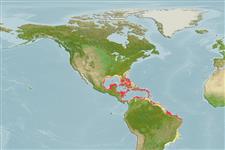>
Eupercaria/misc (Various families in series Eupercaria) >
Haemulidae (Grunts) > Haemulinae
Etymology: Haemulon: Greek, haimaleos = bloody (Ref. 45335).
Environment: milieu / climate zone / depth range / distribution range
Ökologie
seewasser riff-verbunden; tiefenbereich 0 - 60 m (Ref. 36484). Subtropical; 34°N - 34°S, 98°W - 34°W
Western Atlantic: Bermuda, South Carolina (USA), and northern Gulf of Mexico to Brazil; throughout the West Indies and the coasts of Central America (Ref. 3798).
Length at first maturity / Size / Gewicht / Alter
Maturity: Lm 16.0 range ? - ? cm
Max length : 30.0 cm TL Männchen/unbestimmt; (Ref. 7251); common length : 17.0 cm TL Männchen/unbestimmt; (Ref. 3798)
Kurzbeschreibung
Morphologie | Morphometrie
Rückenflossenstacheln (insgesamt): 12; Rückenflossenweichstrahlen (insgesamt): 14-15; Afterflossenstacheln 3; Afterflossenweichstrahlen: 8. Mostly yellow, paler below. Scales below lateral line in oblique rows and much larger than those above lateral line. No other grunt has enlarged scales below the lateral line (Ref. 26938).
Occurs in large schools on rocky and coral reefs, often under ledges or close to elkhorn coral (Ref. 9710). Juveniles abundant in near-shore seagrass beds (Ref. 9710). Feeds mainly on small crustaceans (Ref. 3798). Marketed fresh (Ref. 3798).
Oviparous, distinct pairing during breeding (Ref. 205).
Robins, C.R. and G.C. Ray, 1986. A field guide to Atlantic coast fishes of North America. Houghton Mifflin Company, Boston, U.S.A. 354 p. (Ref. 7251)
IUCN Rote Liste Status (Ref. 130435)
Bedrohung für Menschen
Reports of ciguatera poisoning (Ref. 30303)
Nutzung durch Menschen
Fischereien: kommerziell; Aquarium: Öffentliche Aquarien; Köder: usually
Tools
Zusatzinformationen
Download XML
Internet Quellen
Estimates based on models
Preferred temperature (Ref.
123201): 25.4 - 28, mean 27.2 °C (based on 240 cells).
Phylogenetic diversity index (Ref.
82804): PD
50 = 0.5000 [Uniqueness, from 0.5 = low to 2.0 = high].
Bayesian length-weight: a=0.01380 (0.00879 - 0.02168), b=3.00 (2.87 - 3.13), in cm total length, based on LWR estimates for this species & Genus-body shape (Ref.
93245).
Trophic level (Ref.
69278): 3.5 ±0.1 se; based on diet studies.
Widerstandsfähigkeit (Ref.
120179): mittel, Verdopplung der Population dauert 1,4 - 4,4 Jahre. (K=0.24).
Fishing Vulnerability (Ref.
59153): Low to moderate vulnerability (32 of 100).
Nutrients (Ref.
124155): Calcium = 26.7 [11.5, 74.1] mg/100g; Iron = 0.579 [0.281, 1.123] mg/100g; Protein = 19.5 [17.5, 21.5] %; Omega3 = 0.169 [0.076, 0.330] g/100g; Selenium = 15.4 [7.0, 31.3] μg/100g; VitaminA = 38 [10, 140] μg/100g; Zinc = 0.714 [0.431, 1.162] mg/100g (wet weight);
